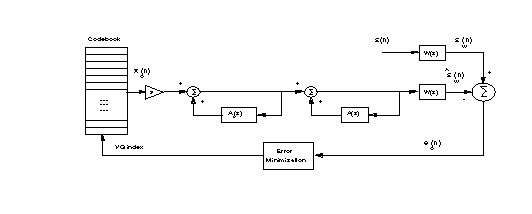Code-Excited Linear Prediction (CELP)
Vector Quantization of LPC
A single code is transmitted rather than a sequence of coded scalar parameters
Typically 10 bit codebooks and 10 LPC coefficients
Searching the VQ vector by measuring the spectral distance between the input vector and every vector in the codebook
Scalar coding can be used for pitch and/or gain
Basic Principles of CELP
What is the advantage of VQ?
Produces low-rate but high-quality speech
The error signal is transmitted
CELP uses standard LPC filters but with a VQ-guided excitation

Short sections of the risidual waveform (up to 5 ms) are coded with typically 10 bit codebooks ( i.e. there are 1024 excitation vectors instead of 2)
Finding the optimal excitation vector is similar to finding optimal LP vectors, i.e. minimizing the squared error